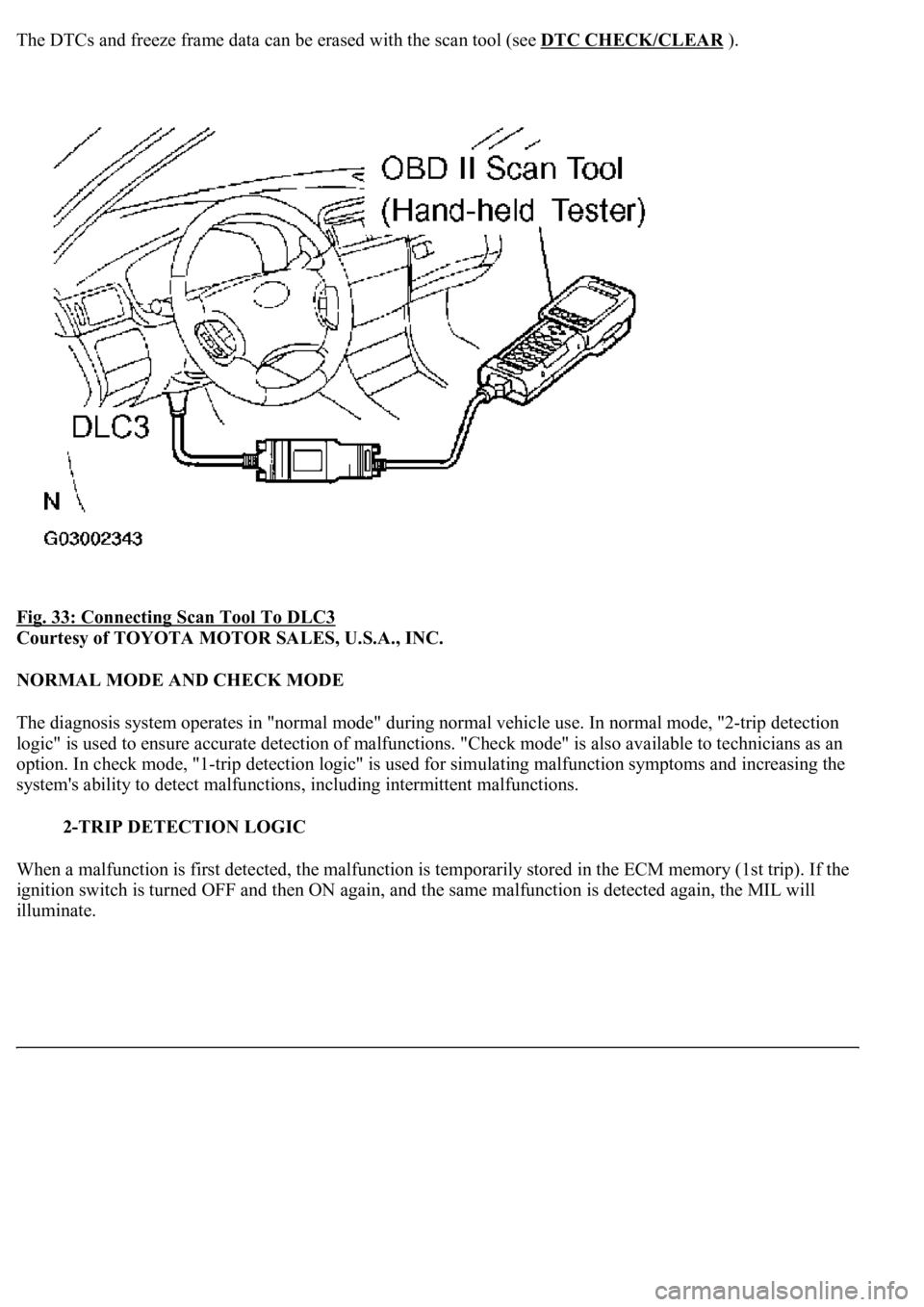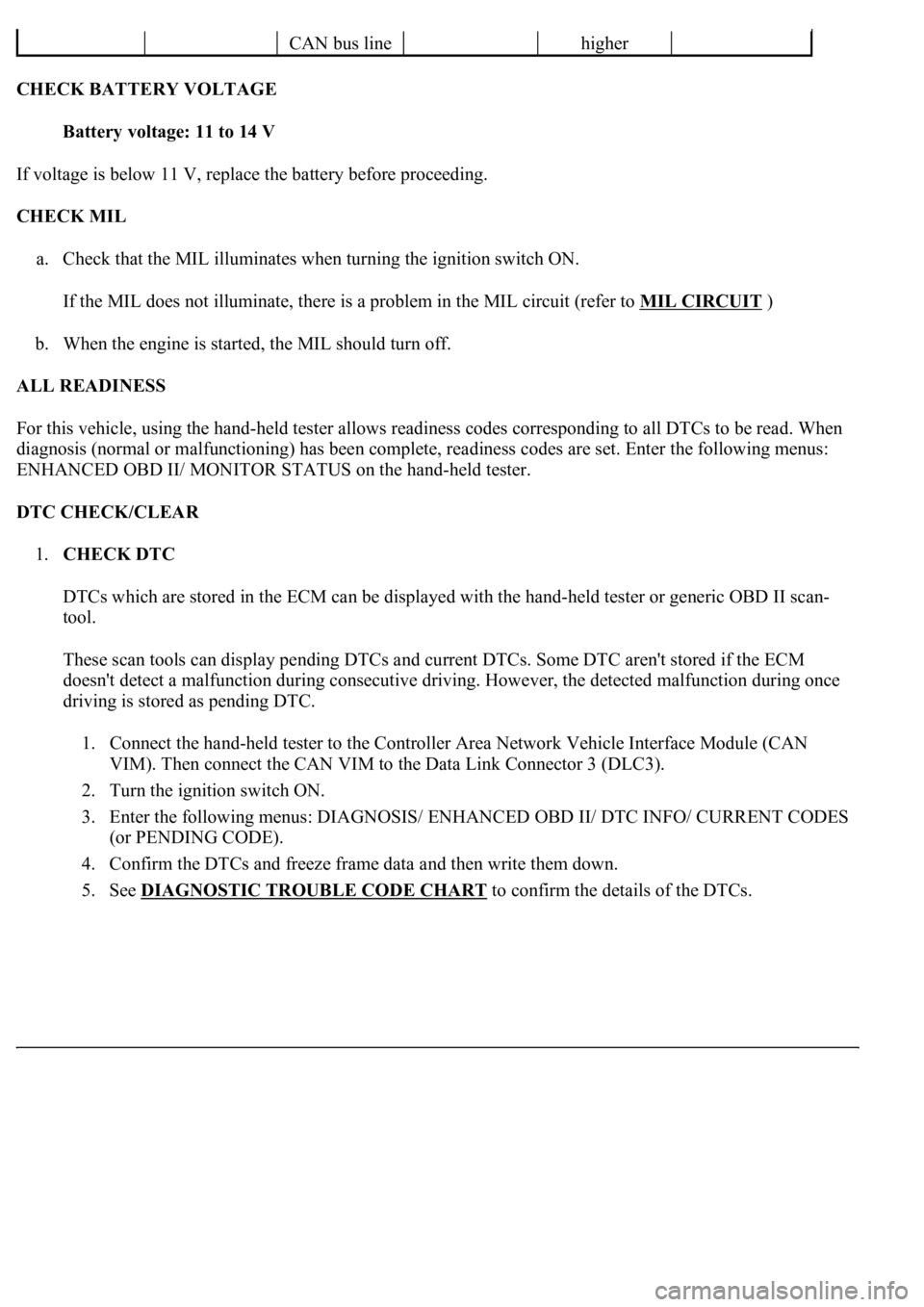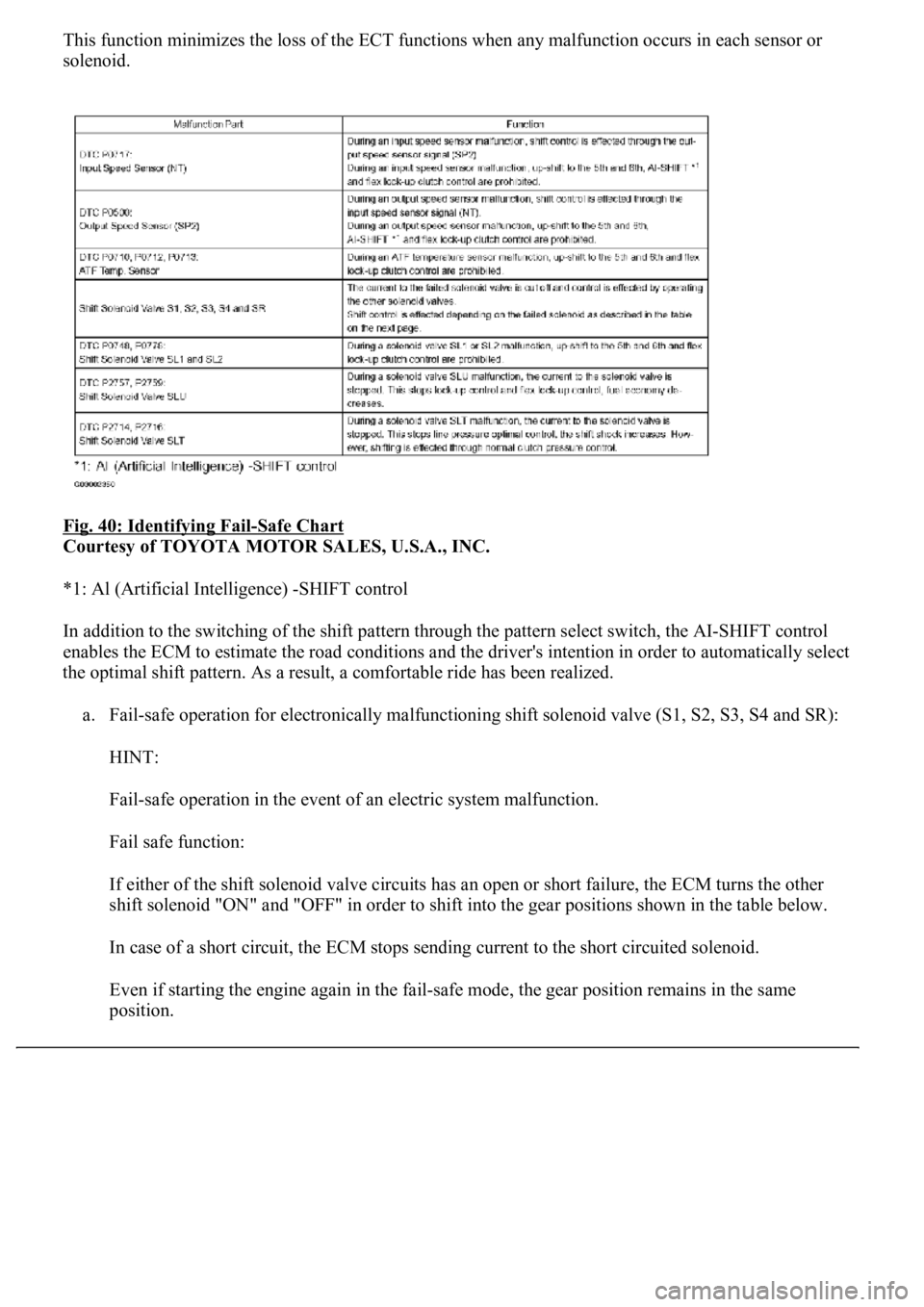Page 2709 of 4500
Fig. 31: Identifying Waveform 6
Courtesy of TOYOTA MOTOR SALES, U.S.A., INC.
Reference:
WAVEFORM 6 REFERENCE TABLE
DIAGNOSIS SYSTEM
DESCRIPTION
When troubleshooting On-Board Diagnostic (OBD II) vehicles, the vehicle must be connected to the OBD II
scan tool (complying with SAE J1987). Various data output from the vehicle's ECM can then be read.
OBD II regulations require that the vehicle's on-board computer illuminates the Malfunction Indicator Lamp
(MIL) on the instrument panel when the computer detects a malfunction in:
1. The emission control s
ystem/components
TerminalSP2+ - SP2-
Tool setting2V/DIV, 20ms/DIV
Vehicle conditionVehicle speed 20 km/h (12 mph)
Page 2710 of 4500
2. The powertrain control components (which affect vehicle emissions)
3. The computer.
In addition, the applicable Diagnostic Trouble Codes (DTCs) prescribed by SAE J2012 are recorded in the
ECM memory. If the malfunction does not reoccur in 3 consecutive trips, the MIL turns off automatically but
the DTCs remain recorded in the ECM memory.
Fig. 32: Identifying Malfunction Indicator Lamp
Courtesy of TOYOTA MOTOR SALES, U.S.A., INC.
To check DTCs, connect the scan tool to the Data Link Connector 3 (DLC3) of the vehicle. The scan tool
displays DTCs, the freeze frame data and a variety of the engine data.
Page 2711 of 4500

The DTCs and freeze frame data can be erased with the scan tool (see DTC CHECK/CLEAR).
Fig. 33: Connecting Scan Tool To DLC3
Courtesy of TOYOTA MOTOR SALES, U.S.A., INC.
NORMAL MODE AND CHECK MODE
The diagnosis system operates in "normal mode" during normal vehicle use. In normal mode, "2-trip detection
logic" is used to ensure accurate detection of malfunctions. "Check mode" is also available to technicians as an
option. In check mode, "1-trip detection logic" is used for simulating malfunction symptoms and increasing the
system's ability to detect malfunctions, including intermittent malfunctions.
2-TRIP DETECTION LOGIC
When a malfunction is first detected, the malfunction is temporarily stored in the ECM memory (1st trip). If the
<004c004a0051004c0057004c0052005100030056005a004c00570046004b0003004c005600030057005800550051004800470003003200290029000300440051004700030057004b0048005100030032003100030044004a0044004c0051000f0003004400
51004700030057004b00480003005600440050004800030050[alfunction is detected again, the MIL will
illuminate.
Page 2713 of 4500
Fig. 35: DTC Freeze Frame Specification
Courtesy of TOYOTA MOTOR SALES, U.S.A., INC.
DLC3 (Data Link Connector 3)
The vehicle's ECM uses the ISO 15765-4 for communication protocol. The terminal arrangement of the DLC3
complies with SAE J1962 and matches the ISO 15765-4 format.
HINT:
Connect the cable of the hand-held tester to the DLC3, turn the ignition switch ON and attempt to use the hand-
held tester. If the screen displays UNABLE TO CONNECT TO VEHICLE, a problem exists in the vehicle side
or the tester side.
If the communication is normal when the tool is connected to another vehicle, inspect the DLC3 on the original
vehicle.
If the communication is still impossible when the tool is connected to another vehicle, the problem is probably
in the tool itself. Consult the Service Department listed in the tool's instruction manual.
Page 2715 of 4500

CHECK BATTERY VOLTAGE
Battery voltage: 11 to 14 V
If voltage is below 11 V, replace the battery before proceeding.
CHECK MIL
a. Check that the MIL illuminates when turning the ignition switch ON.
If the MIL does not illuminate, there is a problem in the MIL circuit (refer to MIL CIRCUIT
)
b. When the engine is started, the MIL should turn off.
ALL READINESS
For this vehicle, using the hand-held tester allows readiness codes corresponding to all DTCs to be read. When
diagnosis (normal or malfunctioning) has been complete, readiness codes are set. Enter the following menus:
ENHANCED OBD II/ MONITOR STATUS on the hand-held tester.
DTC CHECK/CLEAR
1.CHECK DTC
DTCs which are stored in the ECM can be displayed with the hand-held tester or generic OBD II scan-
tool.
These scan tools can display pending DTCs and current DTCs. Some DTC aren't stored if the ECM
doesn't detect a malfunction during consecutive driving. However, the detected malfunction during once
driving is stored as pending DTC.
1. Connect the hand-held tester to the Controller Area Network Vehicle Interface Module (CAN
VIM). Then connect the CAN VIM to the Data Link Connector 3 (DLC3).
2. Turn the ignition switch ON.
3. Enter the following menus: DIAGNOSIS/ ENHANCED OBD II/ DTC INFO/ CURRENT CODES
(or PENDING CODE).
4. Confirm the DTCs and freeze frame data and then write them down.
5. See DIAGNOSTIC TROUBLE CODE CHART
to confirm the details of the DTCs.
CAN bus linehigher
Page 2716 of 4500
Fig. 37: Connecting Hand Held Tester To DLC3
Courtesy of TOYOTA MOTOR SALES, U.S.A., INC.
Turn the ignition switch OFF after the symptom is simulated once. Then repeat the simulation process
again. When the problem has been simulated twice, the MIL illuminates and the DTCs are recorded in the
ECM.
2.CLEAR DTC
a. Connect the hand-held tester to the CAN VIM. Then connect the CAN VIM to the DLC3.
b. Turn the ignition switch ON.
c. Enter the following menus: DIAGNOSIS/ ENHANCED OBD II/ DTC INFO/ CLEAR CODES and
press YES.
CHECK MODE PROCEDURE
DESCRIPTION
Page 2718 of 4500
f. Change the ECM to check mode. Make sure the MIL flashes as shown in the illustration.
g. Start the engine. The MIL should turn off after the engine starts.
h. Perform "MONITOR DRIVE PATTERN" for the ECT test (see MONITOR DRIVE PATTERN
).
(Or, simulate the conditions of the malfunction described by the customer).
i. After simulating the malfunction conditions, use the hand-held tester diagnosis selector to check the DTC
and freeze frame data.
Fig. 39: Identifying MIL Blinking Pattern
Courtesy of TOYOTA MOTOR SALES, U.S.A., INC.
FAIL-SAFE CHART
1.FAIL-SAFE
Page 2719 of 4500

This function minimizes the loss of the ECT functions when any malfunction occurs in each sensor or
solenoid.
Fig. 40: Identifying Fail
-Safe Chart
Courtesy of TOYOTA MOTOR SALES, U.S.A., INC.
*1: Al (Artificial Intelligence) -SHIFT control
In addition to the switching of the shift pattern through the pattern select switch, the AI-SHIFT control
enables the ECM to estimate the road conditions and the driver's intention in order to automatically select
the optimal shift pattern. As a result, a comfortable ride has been realized.
a. Fail-safe operation for electronically malfunctioning shift solenoid valve (S1, S2, S3, S4 and SR):
HINT:
Fail-safe operation in the event of an electric system malfunction.
Fail safe function:
If either of the shift solenoid valve circuits has an open or short failure, the ECM turns the other
shift solenoid "ON" and "OFF" in order to shift into the gear positions shown in the table below.
In case of a short circuit, the ECM stops sending current to the short circuited solenoid.
Even if starting the engine again in the fail-safe mode, the gear position remains in the same
position.